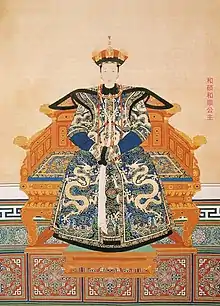Šose
Aisin Gioro Shuose (硕塞; 17 January 1629 - 12 January 1655) was Hong Taiji's fifth son and the first bearer of the Prince Chengze title. In 1655, the peerage was renamed to Prince Zhuang of the First Rank. In 1778, the Prince Chengze of the First Rank peerage was granted iron-cap status, which meant that each successive bearer could pass the title without degradation.
| Šose | |
|---|---|
| Prince Chengzeyu of the First Rank | |
| Prince Zhuang | |
| Tenure | 1644-1655 |
| Successor | Boguoduo |
| Born | 17 January 1629 Qingning palace, Shenyang |
| Died | 12 January 1655 |
| Spouse | Lady Nara Lady Borjigit |
| Issue | Boguoduo Bo'erguoluo Enggebu Princess Heshun of the Second Rank |
| Father | Hong Taiji |
| Mother | Secondary consort, lady Yehe Nara |
Life
Shuose was born on 17 January 1629 in the Qingning palace of the Forbidden City in Mukden, residence of Qing dynasty emperor at that time. His mother, lady Yehe-Nara was a secondary consort of Hong Taiji. Lady Yehe Nara's father, Anabu (阿纳布) was a cousin of Yangginu, the father of Empress Xiaocigao, Monggo Jerjer.[1] Before entry to the imperial household, lady Yehe Nara had been married to Karkama, a leader of Ula valley. After giving birth to Shuose, lady Yehe Nara married minister Zhan Tuxietu. Lady Yehe Nara became a victim of domestic violence shortly after the marriage. The fairly abusive behavior of Zhan Tuxietu led her to the fourth marriage with Darhu (达尔琥), a member of the Hada Nara clan of the Bordered Yellow Banner.[2] Shuose was raised in the Qingning palace together with Bomubogor and Fulin, the future Shunzhi Emperor.[3]
Although Shuose was born to the high-ranking consort, he had no chances to succeed the throne.[4] In June 1644, Shuose married lady Nara, daughter of Feiyanggu and was subsequently granted a title of Prince Chengze of the Second Rank. During transition from Ming to Qing, Shuose followed Dodo, Prince Yu in Shaanzhou.In 1645, he conquered Henan together with Dodo.[5] He captured Li Zicheng's generals Zhang Youseng and Liu Fangliang, later retrieved by the peasant rebelliant.[6] In the battle of Shanhai Pass, Shuose killed Ma Shiyao (马世尧). When Dodo made Khalkha Mongols vassals, Shuose conquerred Datong together with Ajige.[7]
After the death of Dorgon, Shuose was promoted to Prince Chengze of the First Rank in 1651 and served as one of the regents together with Wakeda, Daišan's son and Prince Qian of the Second Rank.[8] Shuose died on 12 January 1655 and was posthumously honoured as Prince Chengzeyu of the First Rank (承澤裕親王, meaning "blessed and abundant"). His successor became eldest son Boguoduo.
Family

- Primary consort, of the Nara clan
皇五子嫡福晋→承泽郡王嫡福晋→承泽亲王嫡福晋→承泽裕亲王嫡福晋- Prince Zhuangjing of the First Rank, Boguoduo, first son
- Prince Hui of the second rank, Bo'erguoluo (博尔果洛), second son
- Princess Heshun of the Second Rank (1648-1691), second daughter[9]
- Married Shang Kexi's son Shang Zhilong[10] in 1660
- Second primary consort, of the Khorchin Borjigin clan, daughter of Manzhuxili
- Secondary consort, of the Khorchin Borjigin clan, daughter of Dalai (达赉)
- Mistress, of the Erdosu clan
- Suiha (随哈), fourth son
- Mistress, of the Mou clan
- General Wenxi of the Second Rank Enggebu (三等温僖辅国将军 鞥额布), third son
References
- 《爱新觉罗宗谱·星源集庆》/ "Genealogy of the Aisin Gioro clan. Stories of the Star Spring".
- Yang/杨, Zhen/珍 (2012). 《关于满文档案与清史研究的几点认识》/ "A role of Manchu archival documents in the history of the Qing dynasty". Beijing: 故宫博物院/Palace Museum. p. 208.
- Yan/颜, Tingrui/廷瑞 (2010). "Empress Dowager Xiaozhuang. Bloody tears at the Qingning palace". Beijing Book Co. Inc.
- Ren, Ji. "Flourishing of the Great Qing". 飛翔時代.
- Yi'ergen Jueluo/伊尔根觉罗, Yongning/永宁 (2006). "12 princes of the Qing dynasty". p. 82.
- Zhao, Erxun (1928). "Draft history of Qing", vol.219.
- Chen/陈, Xiaodan/晓丹 (2013). 中国历史博览4/"Chiese historical sources and objects 4". 青苹果数据中心.
- Zhao, Erxun (1928). "Draft History of Qing. Imperial Princes", table 2.
- 北京档案史料/"Documents from Historical Archives in Beijing", vol 3-4. 《北京档案史料》. 2005. p. 234.
- 《尚氏宗谱》/"Genealogy of the Shang clan".
